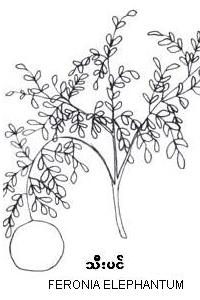Update:
2006-08-09 02:50 PM -0700
TIL
Myanmar Medicinal Plant Database
Family: Rutaceae
compiled by U Kyaw Tun, U Pe Than, and staff of TIL. Not for sale.
Contents of this page
Family: Rutaceae 4 entries
Rutaceae family - general characters
Aegle marmelos {U-thhyis ping}
 -
pronounced as [u-shis ping]
-
pronounced as [u-shis ping]
Citrus medica {rhauk ping}
 - pronounced as [shauk ping]
- pronounced as [shauk ping]
Hesperethusa crenulata / Limonia crenulata
{tha.nap-hka:}

Limonia acidissima /
Feronia elephantum {thi:thi:ping}

Feronia spp.
Hesperethusa spp. -- basis for id of plant
{tha.nap-hka:}

Limonia spp. -- basis for id of plant {thi:thi:ping}

Main Index of DB |
Top
Contents of this page
From: Families yielding important phytopharmaceuticals in
Fundamentals of Pharmacognosy and Phytotherapy, by Michael Heinrich, J.
Barnes, S. Gibbons, and E. Williamson, October 2003, ISBN:0443071322, pp.320 --
www.fleshandbones.com/readingroom/pdf/747.pdf
The family includes some of the most important fruit bearing plants known:
the genus Citrus with orange, lemon, lime, mandarin, grapefruit, etc.
Important medicinal plants from the family
Pilocarpus jaborandi Holmes and Pilocarpus spp. (pilocarpus),
for the isolation of pilocarpine, which is used in ophthalmology.
Ruta graveolens L. (rue), formerly widely used as an emmenagogue and
spasmolytic, shows strong phototoxic side effects.
Many species (especially of the genus Citrus) are aromatic and used as
foods as well as in pharmacy and perfumery.
Morphological characteristics of the family
Most members of this family are trees or shrubs with spirally arranged,
three pinnate or foliate (rarely simple) leaves. The bisexual flowers generally
have five sepals and petals, 5+5 stamens and four or five hypogynous gynaecia.
Distribution
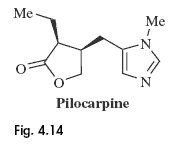 There are approximately 1700 species of this family distributed all over the
world, but the tropics are particularly rich in them.
There are approximately 1700 species of this family distributed all over the
world, but the tropics are particularly rich in them.
Chemical characteristics of the family
Essential oil is common in many taxa (Citrus, Ruta) and can be
found in lysigenous secretory cavities in the parenchyma and pericarp. Alkaloids
are also frequently found, especially benzyltetrahydroisoquinoline, acridone and
imidazole types (pilocarpine; Fig. 4.14). The acridone alkaloids have so far
only been reported from the Rutaceae. Other groups of natural products typically
encountered are furano- and pyranocoumarins (e.g. bergapten from Citrus
aurantium subsp. bergamia, used to flavour Earl Grey tea), as well as
simple coumarins.
Contents of this page
Family: Rutaceae
{U-thhyis ping}
 -
pronounced as [u-shis ping]
-
pronounced as [u-shis ping]
Ref. Burmese-Myanmar transcripts :
Agri.Dept.2000 : NL
Chklist:
LSR 497:
 {U-thhyis ping}
{U-thhyis ping}
FAO 55 : opesheet; ohshit
KS-TMN 198 : Oke-shit
Nagathein 4-095:
 {U-thhyis ping}
{U-thhyis ping}
UHM 2: Okshit
Myanmar-Script Spelling
Official Myanmar Dictionaries
:
 {U-thhyis} -
{U-thhyis} -
 --
TravPo-M-Dict 382
--
TravPo-M-Dict 382
 {U-thhyis} - n. bael fruit, Aegle marmelos - Myan-Engl-Dict 610
{U-thhyis} - n. bael fruit, Aegle marmelos - Myan-Engl-Dict 610
Chklist data:
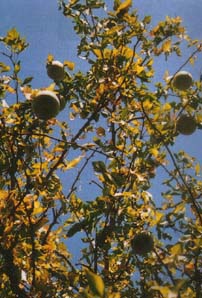
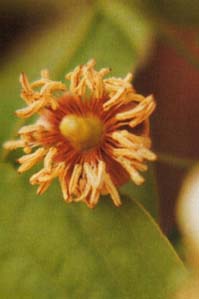 Hindi: Nagathein gives {bιl} for {U-thhyis ping}
Hindi: Nagathein gives {bιl} for {U-thhyis ping}
 and {bι-li.} for {tha.nap-hka:}
and {bι-li.} for {tha.nap-hka:}
 .
.
- Hindi-Myanmar transcriptions by Nagathein are intriguing because the English
name "Bael fruit" is supposedly derived from a Hindi name. I still have to make
out the Hindi-Devanagari words because of poor print quality in Nagathein.
Sanskrit:
English common name used in Myanmar:
Agri.Dept.2000 : NL
Chklist:
LSR 497: Bael Fruit
FAO 55 : Bael
KS-TMN 198 : Bael Fruit Tree, Bengal Quince, Golden Apple, Italy, Fruit,
Indian Quince, Stone Apple.
Nagathein 4-095: Bael Fruit Tree
UHM 2: Bael fruit
Picture :
Leaders: left --Nagathein; right -- FAO
Photos: left -- close up of flower; right -- habit with fruits. Click on the
pictures to enlarge. -- KS-TMN
Plant identification characters :
Key characteristics: Small; deciduous; spines on branches; trunk
base usually fluted; bark grey, cracking vertically into scales; leaves
alternate, trifoliate; flowers greenish-white; fruits with woody shell.
Description: A small, deciduous tree up to 15 m high and 50 cm in diameter
with 12 cm long spines on older branches. Trunk usually fluted at base. The
bark is grey and rather corky and cracks vertically into long scales. Leaves
alternate, trifoliate, on 24 cm long stalk. The two lower leaflets are ovate to
elliptic, up to 7 cm long and 4 cm wide. The terminal leaflet is obovate and
slightly larger (7.5 Χ 4.8 cm). The inflorescence is 45 cm long raceme from the
leaf corners with greenish-white flowers, about 2 cm in diameter. Fruits smooth,
irregular roundish, grey or yellowish, 512.5 cm in diameter, often with hard
woody shell and 610 seeds in clear, sticky pulp. Ecology: Hardy
subtropical species tolerating temperature extremes from -7 to 49°C and growing
on swampy as well as dry soils. Only flowers and fruits well where there is a
prominent dry season. -- FAO
A deciduous tree, small or medium-sized; stems armed with strong
straight sharp axillary spines. Leaves alternate, palmately compound,
trifoliate; exstipulate; petiolate; leafets elliptic, the bases obtuse, the
margins crenate, the tips acute, glabrous, pellucid-punctate, aromatic; lateral
leaflets subsessile, the terminal long-petioluled. Inflorescences
terminal and axillary scorpioid cymes. Flowers ebracteolate, pedicellate,
bisexual, actinomorphic, pentamerous, hypogynous, aromatic. Calyx synsepalous,
5-lobed, sometimes obscure, deciduous. Corolla apopetalous, the petals 5, much
longer than calyx, greenish yellow. Androecium polyandrous, stamens numerous,
the filaments short, inserted to rim of disc, the anthers dithecous, oblongoid,
apiculate, basifixed, introrse, dehiscence longitudinal. Pistil 1, ovary ovoid,
5-lobed, elevated on the disc, 5-carpelled, syncarpous, 5-loculed, the
placentation axile, the ovules numerous in each locule, the style short, the
stigma capitate. Fruit a berry, globose or ovoid, pulpy, the pulp sweet,
thick, orange coloured, rind leathery, woody; seeds oblongoid, numerous, pulp
aromatic, non-endospermic. Flowering period: September-November.
Fruiting period: March-April -- KS-TMN
A medium-sized deciduous tree armed with straight sharp axillary thorns;
leaves alternate, trifoliate, flowers large, white in axillary panicles; fruit
large, globose, ovoid or reniform, many seeds, rind woody. -- UHM
Distribution in Myanmar:
Grows wild or cultivated throughout Myanmar. -- KS-TMN
Minbu, Minhla, Pakokku, Dry Zone, along Moulmein-Mudon road -- UHM
Distribution elsewhere:
From the Indian peninsula, bael has spread to Myanmar, Thailand, Vietnam,
Malaysia, Indonesia and the Philippines. -- FOA
(Caveat : Is there any evidence to the truth of the statement "From the
Indian peninsula, bael has spread to ..."? -- UKT)
Part used and uses :
Fruits are eaten fresh or prepared as sherbet, syrup or marmalade.
From the fruit household glue, dye, tanning agent and various medicines can be
produced. Bark, leaves and roots have a number of medicinal uses and the
bark can also be used as fish poison. The wood can be used for making
small articles such as handles. The tree is very sacred in Hindu religion. --
FAO
Root -- Dysuria; Emesis; Colic; Oligospermia; Gouty arthritis;
Venereal disease; Analgesic; Carminative; Antidote for bites of poisonous
animals; Antidote for snake venom. Bark -- Palpitation of heart; Syncopal
attack; Emesis; Anaemia; Chronic fever; High fever. Bark powder --
Cholera; Gastro-enteritis in children. Leaf -- As an Expectorant;
Carminative; Disinfectant of the mouth; Diarrhoea in puerperium; Diarrhoea;
Infantile diarrhoea; Epihora; Opthalmitis; Asthma; Menopausal disease; Oedema;
Diabetes; Arthritis; Jaundice; Anthelminutic; Indigestion; Flatulence; Otorrhoea;
Gum ache; Boils; Carbuncles; Bad odour of body. Flower -- Dysentery; To
allay thirst; Emesis. Fruit -- Chronic leucorrhoea. Fruit pulp --
Chronic leucorrhoea. Dried pulp -- Carminative; As an expectorant.
Young fruit -- Carminative; Heartburn; Cholera; Polyuria; Diarrhoea
complicating after chicken pox; Dysentery; Chronic dysentery; Amoebic dysentery;
Diahrrhoea during pregnancy; Tinnitus. Mature fruit -- Carminative; As an
expectorant; Good for heart. Unripe fruit -- Dysuria; Diarrhoea;
Dysentery. Ripe fruit -- Constipation; Dysentery; Bilious diarrhoea;
Gastro-enteritis; Minor ailment in pregnancy. -- KS-TMN
Fresh half ripe fruit. Laxative, diuretic, chronic diarrhoea and
dysenteries -- UHM
Constituents :
1. Marmelosin. (5); 2. Mature bark contain ɣ-fragine 0.3%,
umbelliferone 0.6% and marmesin 0.6%. (6) -- UHM
Contents of this page
Family: Rutaceae
{rhauk ping}
 - pronounced as [shauk ping]
- pronounced as [shauk ping]
Ref. Burmese-Myanmar
transcripts :
Agri.Dept.2000 52-1383:
 {rhauk}
{rhauk}
Chklist:
LSR 395:
 {rhauk}
{rhauk}
FAO : NL
KS-TMN 201 : Shauk
Nagathein 3-181:
 {rhauk-hkyiρ thi:}
{rhauk-hkyiρ thi:}
UHM : NL
Myanmar-Script Spelling
Official Myanmar Dictionaries :
 {rhauk} -
{rhauk} -
 - TravPo-M-Dict
280
- TravPo-M-Dict
280
 {rhauk-hkyo} -
{rhauk-hkyo} -
 - TravPo-M-Dict
280
- TravPo-M-Dict
280
 {rhauk-pan:} -
{rhauk-pan:} -
 - TravPo-M-Dict
280
- TravPo-M-Dict
280
 {rhauk} -n. lemon, Citrus limon. - Myan-Engl-Dict 418
{rhauk} -n. lemon, Citrus limon. - Myan-Engl-Dict 418
 {rhauk-hkyo} - n. sweet lime. Citrus medica var limetta. - Myan-Engl-Dict
418
{rhauk-hkyo} - n. sweet lime. Citrus medica var limetta. - Myan-Engl-Dict
418
 {rhauk-pan:} - n. same as
{rhauk-pan:} - n. same as
 {kywθ:kau:} - Myan-Engl-Dict 419
{kywθ:kau:} - Myan-Engl-Dict 419
UKT: The Myan-Engl-Dict 419 entry on
 {rhauk-pan:} as
{rhauk-pan:} as
 {kywθ:kau:}
is questionable because
{kywθ:kau:}
is questionable because
 {kywθ:kau:}
is Citrus grandis or pummelo (Agri.dept.2000 10-0248) and is well-known
in Myanmar.
{kywθ:kau:}
is Citrus grandis or pummelo (Agri.dept.2000 10-0248) and is well-known
in Myanmar.
Chklist data:
Hindi :
Sanskrit :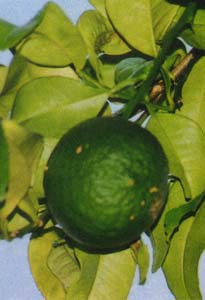

English common name used in Myanmar :
Agri.Dept.2000 52-1383: Lemon
Chklist:
LSR 395: Lemon
FAO : NL
KS-TMN 201 : Citron; Melon Lime; Adam's Apple; Cedrat.
Nagathein 3-181: NG
UHM : NL
Picture :
Leaders: left -
www.tahitifruits.com/images/originales/images_fruits/Gcedra.jpg;
right -
www.philographikon.com/images%20botregbivortgerard/regcitronier.gif
Photos:
left -- habit;
right -- habit with a fruits.
Click on the pictures to enlarge. -- KS-TMN
Plant identification characters :
A small tree; younger stems 3-angled, purplish, the older ones terete,
glabrous, spines axillary. Leaves alternate, palmately compound, unifoliate;
exstipulate; petioles narrowly winged; leaflets elliptic-ovate to
elliptic-oblong, the bases obtuse to rounded, the margins crenate-serrate; the
tips obtuse to cuneate, pellucid-punctate, coriaceous. Inflorescence in axillary
cymes, 2- to 5-flowered; peduncles glabrous; bracts linear, caducous. Flowers pedicellate, bisexual, actinomorphic, pentamerous, hypogynous. Calyx synsepalous,
5-partite, cupular, the lobes ovate, deciduous. Corolla apopetalous, the petals
5, broadly lanceolate, white, tinged pink without, fragrant. Androecium
polyadelphous, stamens 30-40, the filaments flattened, cohering towaeds the
base, inserted round an annualr disc, exserted, the anthers dithecous, oblongoid,
dorsifixed, introrse, dehiscence longitudinal. Pistil 1, ovary 5- to 8-lobed, 5-
to 8-carpelled, syncarpous, 5- to 8-loculed, the placentation axile, the ovules
2-3 in each locule, 2-seriate, the style as long as the filaments, the stigma
capitate. Fruit a hesperidium, obovoid or ellipsoid, obscurely lobed, the apex
broadly mammillate, the bases collared, rind leathery, the pulp juicy, acid;
seeds numerous, ovoid, endospermic. Flowering period: April-May.
Fruiting period: June-August -- KS-TMN
Distribution in Myanmar :
Grows wild or commonly cultivated throughout Myanmar. -- KS-TMN
Parts used and uses:
Root -- Gastrointestinal colic; Cholera;
Emesis; Constipation; Infections; Inflammations; Urinary infection; Haemorrhoid;
Lithiasis; Tooth diseases. Buds and flowers -- Antiemetic; Appetizer;
Gives energy; Asthma; Whooping cough; Giddiness; Promotes peristalsis of the
intestine. Young fruit -- Carminative; Expectorant; Biliousness. Ripe
fruit -- Heartburn; Appetizer; Antiseptic for throat; Easily digested;
Haematemesis; To allay thirst; Hiccough; Gains weight; Analgesic; Dyspepsia;
Good for heart; Carminative; Chest pain: Mucolytic; Asthma; Gives energy;
Whooping cough; Oedema; Cough; Laryngitis; Leprosy. Fruit rind --
Mucolytic; Colic; Back-ache; Loss of appetite; Biliousness. Inner layers of
rind -- Analgesic; Colic; Back-ache; Loss of appetite; Biliousness. Juicy
layers -- Heartburn; Appetizer; Chest pain; Easily digested; Abdominal
tumours; Asthma; Cough; Hiccough; Psychosis; Oedema; Emesis; Haemorrhoids.
Juicy layers -- Instestinal colic; Cystitis; Loss of appetitie; Asthma;
Cough. Infusion -- Emesis; Otalgia. Seed -- Mucolytic;
Haemorrhoids; Heartburn; Inflammations; Hard to digest; Carminative;
Biliousness; Gives energy. Embryo in seed -- Appetizer; Gives energy;
Carminative; Mucolytic. -- KS-TMN
Constituents :
Contents of this page
Family: Rutaceae
UKT: {tha.nap-hka:}

UKS-TMN probably was mistaken in identifying
 {tha.nap-hka:} as
Limonia crenulata. Chklist identified it as Hesperethusa crenulata.
However, Chklist could also be wrong, because I could not find even the genus
Hesperethusa in USDA-NRCS among the
American plants (-- admittedly a very weak argument). Out of my respect for Mr.
Hundley and U Chit Ko Ko (Chklist), I have taken
the name Hesperethusa crenulata for {tha.nap-hka:}.
{tha.nap-hka:} as
Limonia crenulata. Chklist identified it as Hesperethusa crenulata.
However, Chklist could also be wrong, because I could not find even the genus
Hesperethusa in USDA-NRCS among the
American plants (-- admittedly a very weak argument). Out of my respect for Mr.
Hundley and U Chit Ko Ko (Chklist), I have taken
the name Hesperethusa crenulata for {tha.nap-hka:}.
Identification of the plant {thi:thi:ping}
 is also controversial. I have taken
the name Limonia acidissima for it
based on Chklist.
is also controversial. I have taken
the name Limonia acidissima for it
based on Chklist.
The sections on Hesperethusa
crenulata and Limonia acidissima must
be read together.
Ref. Burmese-Myanmar
transcripts :
Agri.Dept.2000 57-1509 :
 {tha.nap-hka:} - Limonia accidissima (Chinese box tree)
{tha.nap-hka:} - Limonia accidissima (Chinese box tree)
Chklist:
Thanakha, Thi-ha-yaza
LSR 463:
 {tha.nap-hka:} - Limonia accidissima (Chinese box tree)
{tha.nap-hka:} - Limonia accidissima (Chinese box tree)
FAO : NL
KS-TMN 202: Thanat-kha; Thi-ha-yaza - Limonia crenulata (Eng. -- NG)
Nagathein 3-353:
 {tha.nap-hka: ping} - Limonia accidissima
(Eng. -- NG)
{tha.nap-hka: ping} - Limonia accidissima
(Eng. -- NG)
UHM : NL
Chklist (online): Hesperethusa crenulata (Roxb.) Roem.
, Common Names: Sansph-ka,
Thanakha, Thi-ha-yaza
Myanmar-Script Spelling
Official Myanmar Dictionaries :
 {tha.nap-hka:} --
{tha.nap-hka:} --
 - TravPo-M-Dict
318
- TravPo-M-Dict
318
 {tha.nap-hka:} -- n. a kind of tree the bark and root of which are used in
making a fragrant paste for cosmetic purposes, Limonea acidissima
- Myan-Engl-Dict 487
{tha.nap-hka:} -- n. a kind of tree the bark and root of which are used in
making a fragrant paste for cosmetic purposes, Limonea acidissima
- Myan-Engl-Dict 487
Chklist data:
Hesperethusa crenulata (Roxb.) Roem. Habit: Small
tree. Distribution: Bago, Magway, Mandalay, Sagaing. Common Names: Sansph-ka,
Thanakha, Thi-ha-yaza
Hindi :
Sanskrit :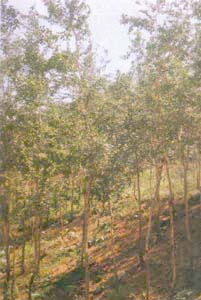
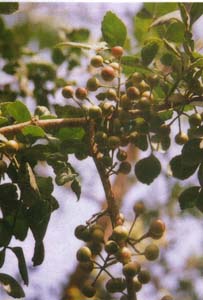
English common name used in Myanmar :
Agri.Dept.2000 : Chinese box tree
Chklist:
LSR 463: Chinese box tree
FAO : NL
KS-TMN 202: Thanat-kha; Thi-ha-yaza - Limonia crenulata (Eng. -- NG)
Nagathein 3-353:
 {tha.nap-hka: ping} - Limonia accidissima
(Eng. -- NG)
{tha.nap-hka: ping} - Limonia accidissima
(Eng. -- NG)
UHM : NL
Picture :
Leader: left -
http://forum.kita.net/club/pro/file/110049654837903.jpeg ; right - Nagathein
Photos:
left -- habit with fruits;
right -- habit.
Click on the pictures to enlarge. -- KS-TMN
UKT: The pix of
 {kyauk-pyiρ} of the leader was listed under
Limonia
acidissima (which to my understanding is {thi:ping}. Since {thi:} bark is
also used similar to {tha.nap-hka:}, the pix is equally applicable to Hesperethusa crenulata
(
{kyauk-pyiρ} of the leader was listed under
Limonia
acidissima (which to my understanding is {thi:ping}. Since {thi:} bark is
also used similar to {tha.nap-hka:}, the pix is equally applicable to Hesperethusa crenulata
( {tha.nap-hka:}). The pix shows a section of a stem with the bark intact with a
flat specially made "grind-stone" used to make paste which is directly applied
to the skin as skin-care. Caveat: Do not let the Burmese-Myanmar suffixes
{ping} and {thi:} (second syllable in {thi:thi:ping}) mislead you -- they simply
mean 'plant' and 'fruit' in Burmese.
{tha.nap-hka:}). The pix shows a section of a stem with the bark intact with a
flat specially made "grind-stone" used to make paste which is directly applied
to the skin as skin-care. Caveat: Do not let the Burmese-Myanmar suffixes
{ping} and {thi:} (second syllable in {thi:thi:ping}) mislead you -- they simply
mean 'plant' and 'fruit' in Burmese.
Plant identification characters :
A spinous shrub or a small tree; branches woody; rigid, flexuous, spines sharp.
Leaves alternate, unipinnately compound, imparipinnate; exstipulate; petioles
and rachis winged; leaflets 2-4 pairs, opposite, elliptic-ovate, the bases
obtuse to cuneate, the margins crenulate, the tips obtuse, rarely acute,
glabrous. Inflorescences in axillary cymes, the cymules 1-3 per axil. Flowers ebracteolate, ebracteolate, pedicellate, bisexual, actinomorphic, tetramerous,
hypogynous. Calyx synsepalous, small, 4-lobed, the lobes broadly ovate, acute.
Corolla apopetalous, the petals 4, elliptic-oblong, glandular, white, fragrant.
Androecium polyandrous, stamens 8, 2-seriate, the outer whorl opposite the
petals, subequal, inserted around a stipitiform disc, the filaments linear-subulate,
the anthers dithecous, oblongoid, dorsifixed, introrse, dehiscence longitudinal.
Pistil 1, ovary oblongoid, papillose, 4-carpelled, syncarpous, 4-loculed, the
ovule solitary in each locule, the placentation axile, the style thick and
stout, the stigma capitate. Fruit a berry, globose, very acid; seeds 1-4,
embedded in mucilage, non-edospermic. Flowering period: April-June.
Fruiting period: June-August. -- KS-TMN
Distribution in Myanmar :
Grows wild in dry low plains of Upper Myanmar. Also cultivated. -- KS-TMN
Part
used and uses :
Root
-- Antipyretic for high fevers; Prevention of small pox; Antidote for many
poisons; Flatulence; Chest pain; Heart pain; Purgative. Leaf -- Epilepsy.
-- KS-TMN
Constituents :
Contents of this page
Family: Rutaceae
UKT: {thi:thi:ping}

UKS-TMN probably was mistaken in identifying
 {tha.nap-hka:} as
Limonia crenulata. Chklist identified it as Hesperethusa crenulata.
However, Chklist could also be wrong, because I could not find even the genus
Hesperethusa in USDA-NRCS among the
American plants (-- admittedly a very weak argument). Out of my respect for Mr.
Hundley and U Chit Ko Ko (Chklist), I have taken
the name Hesperethusa crenulata for {tha.nap-hka:}.
{tha.nap-hka:} as
Limonia crenulata. Chklist identified it as Hesperethusa crenulata.
However, Chklist could also be wrong, because I could not find even the genus
Hesperethusa in USDA-NRCS among the
American plants (-- admittedly a very weak argument). Out of my respect for Mr.
Hundley and U Chit Ko Ko (Chklist), I have taken
the name Hesperethusa crenulata for {tha.nap-hka:}.
Identification of the plant {thi:thi:ping}
 is also controversial. I have taken
the name Limonia acidissima for it
based on Chklist.
is also controversial. I have taken
the name Limonia acidissima for it
based on Chklist.
The sections on Hesperethusa
crenulata and Limonia acidissima
must be read together.
Ref. Burmese-Myanmar
transcripts :
Agri.Dept.2000 58-1560:
 {thi:}
as Ferionia elephantum
{thi:}
as Ferionia elephantum
Chklist: Thi
FAO : NL
LSR 437:  {thI:
ping}
as Ferionia elephantum
{thI:
ping}
as Ferionia elephantum
KS-TMN : NL
Nagathein 3-412:
 {thI:
ping}
as Ferionia elephantum
{thI:
ping}
as Ferionia elephantum
UHM : NL
Myanmar-Script Spelling
Official Myanmar Dictionaries :
 {thi:}
-
{thi:}
-
 - TravPo-M-Dict
324
- TravPo-M-Dict
324
 {thi:}
- n. wood apple tree, Ferionia elephantum - Myan-Engl-Dict
497
{thi:}
- n. wood apple tree, Ferionia elephantum - Myan-Engl-Dict
497
Chklist data:
Limonia acidissima L. Cited as: Feronia elephantum Correa,
Limonia elephantum (Correa) Panigrahi. Habit: Tree. Distribution: Magway,
Mandalay. Common Names: Elephant apple, Kwet, Mak-pyen-Sum, Thi, Wood
apple
Hindi : 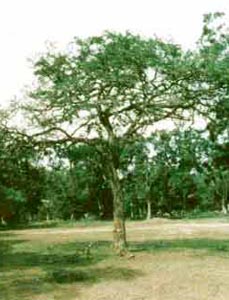

Sanskrit
English common name used in Myanmar :
Agri.Dept.2000 58-1560: Wood apple; Elephant apple
Chklist: Elephant apple, Wood apple
FAO : NL
LSR 437: Elephant apple
KS-TMN : NL
Nagathein 3-412: NG
UHM : NL
Picture :
Leader: left -
http://forum.kita.net/club/pro/file/110049654837903.jpeg ; right - Nagathein
Photo: left -
http://forum.kita.net/club/pro/file/110049654837903.jpeg ;
right -
www.fao.org/docrep/x2230e/x2230e68.jpg
UKT: The pix of
 {kyauk-pyiρ} of the leader was listed under
Limonia
acidissima (which to my understanding is {thi:ping}. Since {thi:} bark is
also used similar to {tha.nap-hka:}, the pix is equally applicable to Hesperethusa crenulata
(
{kyauk-pyiρ} of the leader was listed under
Limonia
acidissima (which to my understanding is {thi:ping}. Since {thi:} bark is
also used similar to {tha.nap-hka:}, the pix is equally applicable to Hesperethusa crenulata
( {tha.nap-hka:}). The pix shows a section of a stem with the bark intact with a
flat specially made "grind-stone" used to make paste which is directly applied
to the skin as skin-care. Caveat: Do not let the Burmese-Myanmar suffixes
{ping} and {thi:} (second syllable in {thi:thi:ping}) mislead you -- they simply
mean 'plant' and 'fruit' in Burmese.
{tha.nap-hka:}). The pix shows a section of a stem with the bark intact with a
flat specially made "grind-stone" used to make paste which is directly applied
to the skin as skin-care. Caveat: Do not let the Burmese-Myanmar suffixes
{ping} and {thi:} (second syllable in {thi:thi:ping}) mislead you -- they simply
mean 'plant' and 'fruit' in Burmese.
Plant identification characters :
Feronia limonia Swingle / Feronia elephantum Correa / Limonia acidissima L.
/ Schinus limonia L. -- The wood-apple, Feronia limonia Swingle (syns. F. elephantum
Correa; Limonia acidissima L.; Schinus limonia L.) is the only
species of its genus, in the family Rutaceae. Besides wood-apple, it may be
called elephant apple, monkey fruit, curd fruit, kath bel and other
dialectal names in India. In Malaya it is gelinggai or belinggai;
in Thailand, ma-khwit; in Cambodia, kramsang; in Laos, ma-fit.
In French, it is pomme d' elephant, pomme de bois, or citron des
mois. Varieties: There are 2 forms, one with large, sweetish fruits;
one with small, acid fruits. Description: The slow-growing tree is erect,
with a few upward-reaching branches bending outward near the summit where they
are subdivided into slender branchlets drooping at the tips. The bark is ridged,
fissured and scaly and there are sharp spines :3/4 to 2 in (2-5 cm) long on some
of the zigzag twigs. The deciduous, alternate leaves, 3 to 5 in (7.5-12.5 cm)
long, dark-green, leathery, often minutely toothed, blunt or notched at the
apex, are dotted with oil glands and slightly lemon-scented when crushed.
Dull-red or greenish flowers to 1/2 in (1.25 cm) wide are borne in small, loose,
terminal or lateral panicles. They are usually bisexual. The fruit is round to
oval, 2 to 5 in (5-12.5 cm) wide, with a hard, woody, grayish-white, scurfy rind
about 1/4 in (6 mm) thick. The pulp is brown, mealy, odorous, resinous,
astringent, acid or sweetish, with numerous small, white seeds scattered through
it. --
www.hort.purdue.edu/newcrop/morton/wood-apple.html
Distribution in Myanmar :
Distribution elsewhere:
The wood-apple is native and common in the wild in dry plains of India and
Ceylon and cultivated along roads and edges of fields and occasionally in
orchards. It is also frequently grown throughout Southeast Asia, in northern
Malaya and on Penang Island. In India, the fruit was traditionally a "poor man's
food" until processing techniques were developed in the mid-1950's. Climate:
The tree grows up to an elevation of 1,500 ft (450 m) in the western Himalayas.
It is said to require a monsoon climate with a distinct dry season. Season:
In Malaya, the leaves are shed in January, flowering occurs in February and
March, and the fruit matures in October and November. In India, the fruit ripens
from early October through March. Soil: Throughout its range there is a
diversity of soil types, but it is best adapted to light soils. Propagation: The wood-apple is generally grown from seeds though seedlings will not
bear fruit until at least 15 years old. Multiplication may also be by root
cuttings, air-layers, or by budding onto self-seedlings to induce dwarfing and
precociousness. Harvesting: The fruit is tested for maturity by dropping
onto a hard surface from a height of 1 ft (30 cm). Immature fruits bounce, while
mature fruits do not. After harvest, the fruit is kept in the sun for 2 weeks to
fully ripen.
www.hort.purdue.edu/newcrop/morton/wood-apple.html
Part
used and uses :
Food: The rind must be cracked with a hammer. The scooped-out pulp,
though sticky, is eaten raw with or without sugar, or is blended with coconut
milk and palm-sugar syrup and drunk as a beverage, or frozen as an ice cream. It
is also used in chutneys and for making jelly and jam. The jelly is purple and
much like that made from black currants. A bottled nectar is made by diluting the pulp with water, passing
through a pulper to remove seeds and fiber, further diluting, straining, and
pasteurizing. A clear juice for blending with other fruit juices, has been
obtained by clarifying the nectar with Pectinol R-10. Pulp sweetened with syrup
of cane or palm sugar, has been canned and sterilized. The pulp can be
freeze-dried for future use but it has not been satisfactorily dried by other
methods. Other uses: Pectin -- The pectin has potential for multiple uses in pectin-short India,
but it is reddish and requires purification. Rind: The fruit shell is
fashioned into snuffboxes and other small containers. Gum: The trunk and
branches exude a white, transparent gum especially following the rainy season.
It is utilized as a substitute for, or adulterant of, gum arabic, and is also
used in making artists' watercolors, ink, dyes and varnish. It consists of 35.5%
arabinose and xylose, 42.7% d-galactose, and traces of rhamnose and
glucuronic acid. Wood: The wood is yellow-gray or whitish, hard, heavy,
durable, and valued for construction, pattern-making, agricultural implements,
rollers for mills, carving, rulers, and other products. It also serves as fuel.
The heartwood contains ursolic acid and a flavanone glycoside, 7-methylporiol-β
-D-xylopyranosyl-D-glucopyranoside. Medicinal Uses: The fruit is much used in India as a liver and cardiac
tonic, and, when unripe, as an astringent means of halting diarrhea and
dysentery and effective treatment for hiccough, sore throat and diseases of the
gums. The pulp is poulticed onto bites and stings of venomous insects, as is the
powdered rind. Juice of young leaves is mixed with milk and sugar candy and given as a
remedy for biliousness and intestinal troubles of children. The powdered gum,
mixed with honey, is given to overcome dysentery and diarrhea in children. Oil derived from the crushed leaves is applied on itch and the leaf decoction
is given to children as an aid to digestion. Leaves, bark, roots and fruit pulp
are all used against snakebite. The spines are crushed with those of other trees
and an infusion taken as a remedy for menorrhagia. The bark is chewed with that
of Barringtonia and applied on venomous wounds.
www.hort.purdue.edu/newcrop/morton/wood-apple.html
Constituents :
Food value per 100g. of edible pulp (ripe): moisture, 74.0%; protein, 8.00%;
fat, 1.45%; carbohydrates, 7.45%; ash, 5.0%; calcium, 0.17%; phosphorus, 0.08%;
iron, 0.07%; tannins, 1.03% (according to analysis in India).
Food value per 100g. of edible seeds: moisture, 4.0%; protein, 26.18%;
27%; carbohydrates; 35.49%; ash; 5.03%; calcium, 1.58%; phosphorus, 1.43%;
iron, 0.03%; tannins, 0.08% (according to analysis in India).
The pulp represents 36% of the whole fruit. The pectin content of the pulp is
3 to 5% (16% yield on dry-weight basis). The seeds contain a bland, non-bitter,
oil high in unsaturated fatty acids. The unripe fruits contain 0.015% stigmasterol. Leaves contain stigmasterol
(0.012%) and bergapten (0.01%). The bark contains 0.016% marmesin. Root bark
contains aurapten, bergapten, isopimpinellin and other coumarins.
www.hort.purdue.edu/newcrop/morton/wood-apple.html
Contents of this page
Family: Rutaceae
Results of search for 'Feronia' in the Checklist of Plants
of Myanmar, U.S. National Herbarium, 9 Aug 2006.
Limonia acidissima L. Cited as: Feronia elephantum Correa,
Limonia elephantum (Correa) Panigrahi. Habit: Tree. Distribution:
Magway, Mandalay. Common Names: Elephant apple, Kwet, Mak-pyen-Sum, Thi,
Wood apple
Contents of this page
Family: Rutaceae
UKT: -- basis for id of plant {tha.nap-hka:}

Results of search for 'Hesperethusa' in the Checklist of Plants
of Myanmar, U.S. National Herbarium, 9 Jun 2006.
Hesperethusa crenulata (Roxb.) Roem. Habit: Small
tree. Distribution: Bago, Magway, Mandalay, Sagaing. Common Names: Sansph-ka,
Thanakha, Thi-ha-yaza
USDA-NRCS
UKT (as of 060610): I could not find either Hesperethusa or
Hesperethusa crenulata in USDA-NRCS-data file.
It is to be noted that KS-TMN has identified {tha.nap.hka:} as
Limonia crenulata .
Contents of this page
Family: Rutaceae
UKT: -- basis for id of plant
 {thi:thi:ping}
{thi:thi:ping}
Results of search for 'Limonia' in the Checklist of Plants of
Myanmar, U.S. National Herbarium, 9 Jun 2006.
Limonia acidissima L. Cited as:
Feronia elephantum Correa,
Limonia elephantum (Correa) Panigrahi. Habit: Tree. Distribution: Magway, Mandalay. Common Names: Elephant apple, Kwet, Mak-pyen-Sum,
Thi, Wood apple
Limonia alternans Wall. ex Voigt. Habit: Tree. Distribution: Reported from Myanmar.
Limonia flavicans Wall. ex Hook. f. Habit: Tree. Distribution: Reported from Myanmar
Limonia mauritiana Lam. Cited as: Glycosmis mauritiana (Lam.)
Tanaka. Habit: Tree. Distribution: Reported from Myanmar
Limonia pubescens Wall. Habit: Tree. Distribution: Reported from Myanmar
USDA-NRCS
"LIAU7","Limonia aurantifolia Christm. [orthographic variant]",">>Citrus
Χaurantiifolia","Rutaceae"
"LIAU9","Limonia aurantiifolia Christm.",">>Citrus Χaurantiifolia","Rutaceae"
"LIMON2","Limonia L.","limonia","Rutaceae"
"LIAC5","Limonia acidissima L.","Indian woodapple","Rutaceae"
"FELI3","Feronia limonia (L.) Swingle",">>Limonia acidissima","Rutaceae"
Contents of this page
Entry format: Botanical name / Family / Ref. Burmese-Myanmar
transcripts ( Agri.Dept.2000 :
Chklist: LSR : FAO : KS-TMN:
Nagathein :
UHM :/ Myanmar-Script Spelling (
Official Myanmar Dictionaries : - TravPo-M-Dict - Myan-Engl-Dict - Myan-Ortho
/ Chklist data / Hindi /
Sanskrit / English common name used in Myanmar / Picture /
Plant identification characters / Distribution in Myanmar / Part
used and uses / Constituents /
End of TIL file
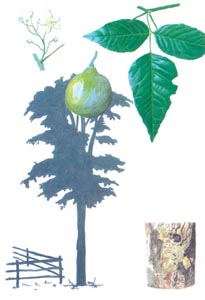
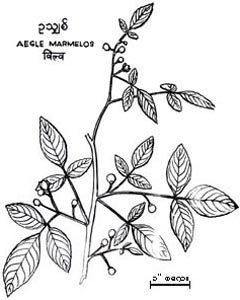

 Hindi: Nagathein gives {bιl} for {U-thhyis ping}
Hindi: Nagathein gives {bιl} for {U-thhyis ping}
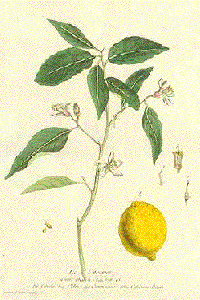


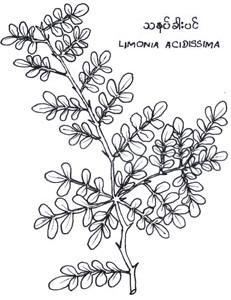
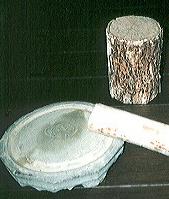 /
/ 

